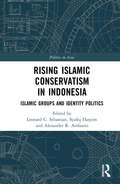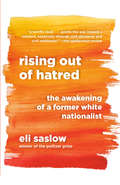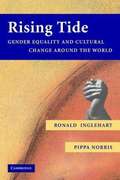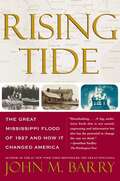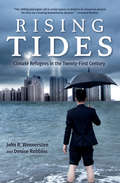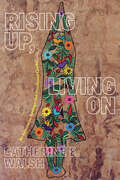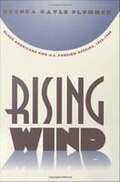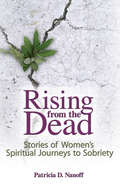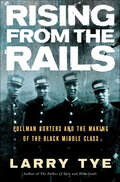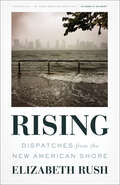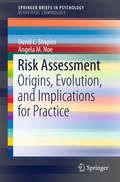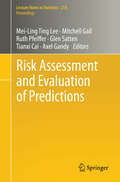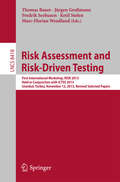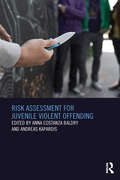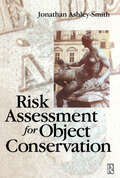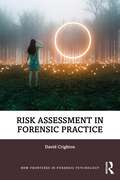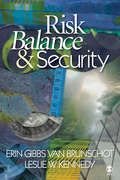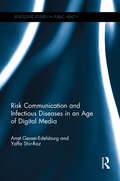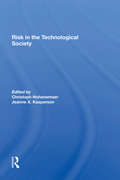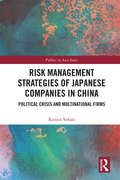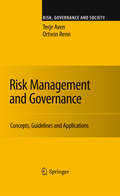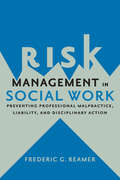- Table View
- List View
Rising Islamic Conservatism in Indonesia: Islamic Groups and Identity Politics (Politics in Asia)
by Leonard C. Sebastian, Syafiq Hasyim and Alexander R. ArifiantoThis edited volume argues that the rise of Islamic conservatism poses challenges to Indonesia’s continued existence as a secular state, with far-reaching implications for the social, cultural and political fortunes of the country. It contributes a model of analysis in the field of Indonesian and Islamic studies on the logic of Islamic conservative activism in Indonesia. This volume presents informative case studies of discourses and expressions of Islamic conservatism expressed by leading mainstream and upcoming Indonesian Islamic groups and interpret them in a nuanced perspective. All volume contributors are Indonesian-based Islamic Studies scholars with in-depth expertise on the Islamic groups they have studied closely for years, if not decades. This book is an up-to-date study addressing contemporary Indonesian politics that should be read by Islamic Studies, Indonesian Studies, and more broadly Southeast Asian Studies specialists. It is also a useful reference for those studying Religion and Politics, and Comparative Politics.
Rising Out of Hatred: The Awakening of a Former White Nationalist
by Eli SaslowFrom a Pulitzer Prize-winning reporter, the powerful story of how a prominent white supremacist changed his heart and mindDerek Black grew up at the epicenter of white nationalism. His father founded Stormfront, the largest racist community on the Internet. His godfather, David Duke, was a KKK Grand Wizard. By the time Derek turned nineteen, he had become an elected politician with his own daily radio show - already regarded as the "the leading light" of the burgeoning white nationalist movement. "We can infiltrate," Derek once told a crowd of white nationalists. "We can take the country back." Then he went to college. Derek had been home-schooled by his parents, steeped in the culture of white supremacy, and he had rarely encountered diverse perspectives or direct outrage against his beliefs. At New College of Florida, he continued to broadcast his radio show in secret each morning, living a double life until a classmate uncovered his identity and sent an email to the entire school. "Derek Black...white supremacist, radio host...New College student???" The ensuing uproar overtook one of the most liberal colleges in the country. Some students protested Derek's presence on campus, forcing him to reconcile for the first time with the ugliness his beliefs. Other students found the courage to reach out to him, including an Orthodox Jew who invited Derek to attend weekly Shabbat dinners. It was because of those dinners--and the wide-ranging relationships formed at that table--that Derek started to question the science, history and prejudices behind his worldview. As white nationalism infiltrated the political mainstream, Derek decided to confront the damage he had done. Rising Out of Hatred tells the story of how white-supremacist ideas migrated from the far-right fringe to the White House through the intensely personal saga of one man who eventually disavowed everything he was taught to believe, at tremendous personal cost. With great empathy and narrative verve, Eli Saslow asks what Derek's story can tell us about America's increasingly divided nature. This is a book to help us understand the American moment and to help us better understand one another.
Rising Tide: Gender Equality and Cultural Change Around the World
by Pippa Norris Ronald InglehartThe twentieth century gave rise to profound changes in traditional sex roles. This study reveals how modernization has changed cultural attitudes towards gender equality and analyzes the political consequences. It systematically compares attitudes towards gender equality worldwide, comparing almost 70 nations, ranging from rich to poor, agrarian to postindustrial. This volume is essential reading to gain a better understanding of issues in comparative politics, public opinion, political behavior, development and sociology.
Rising Tide: The Great Mississippi Flood of 1927 and How It Changed America
by John M. BarryA New York Times Notable Book of the Year, winner of the Southern Book Critics Circle Award and the Lillian Smith Award.An American epic of science, politics, race, honor, high society, and the Mississippi River, Rising Tide tells the riveting and nearly forgotten story of the Great Mississippi Flood of 1927. The river inundated the homes of almost one million people, helped elect Huey Long governor and made Herbert Hoover president, drove hundreds of thousands of African Americans north, and transformed American society and politics forever. The flood brought with it a human storm: white and black collided, honor and money collided, regional and national powers collided. New Orleans&’s elite used their power to divert the flood to those without political connections, power, or wealth, while causing Black sharecroppers to abandon their land to flee up north. The states were unprepared for this disaster and failed to support the Black community. The racial divides only widened when a white officer killed a Black man for refusing to return to work on levee repairs after a sleepless night of work. In the powerful prose of Rising Tide, John M. Barry removes any remaining veil that there had been equality in the South. This flood not only left millions of people ruined, but further emphasized the racial inequality that have continued even to this day.
Rising Tides: Climate Refugees in the Twenty-First Century (Encounters: Explorations in Folklore and Ethnomusicology)
by John R. Wennersten and Denise Robbins&“Deals masterfully with a neglected crisis, how climate change is driving migration . . . The work broaches solutions both practical . . . and political.&”—Christopher E. Goldthwait, former US Ambassador With global climate change upon us, it is imperative to start thinking about the massive numbers of people who will be displaced by environmental crises. The rise in sea levels alone will account for hundreds of millions of refugees around the globe. In Rising Tides, John R. Wennersten and Denise Robbins face the difficult questions that will have to be answered: How will people be relocated and settled? Is it possible to offer environmental refugees temporary or permanent asylum? Will these refugees have any collective rights in the new areas they inhabit? And lastly, who will pay the costs of all the affected countries during the process of resettlement? Offering an essential, continent-by-continent look at these dangers, Rising Tides is &“a passionately argued, well-documented wake-up call on the dire, current and undeniable human fallout from climate change. Looking behind the headlines, it connects the dots in a way that will inform and should alarm us all&” (Eugene L. Meyer, author of Five for Freedom). &“This chilling and urgent call to action spares no detail in its mission to present the facts on a looming humanitarian disaster. Climate-change warning messages too often focus on the environment without going into specifics of how humans will be hurt by global warming. Rising Tides singlehandedly rectifies this issue.&”—Foreword Reviews &“A must read for policymakers and those in positions of power, especially the ones who remain in a state of denial about climate change and refuse to do enough to address the crisis.&”—The Hindu
Rising Up, Living On: Re-Existences, Sowings, and Decolonial Cracks (On Decoloniality)
by Catherine E. WalshIn Rising Up, Living On, Catherine E. Walsh examines struggles for existence in societies deeply marked by the systemic violences and entwinements of coloniality, capitalism, Christianity, racism, gendering, heteropatriarchy, and the continual dispossession of bodies, land, knowledge, and life, while revealing practices that contest and live in the cracks of these matrices of power. Through stories, narrations, personal letters, conversations, lived accounts, and weaving together the thought of many—including ancestors, artists, students, activists, feminists, collectives, and Indigenous and Africana peoples—in the Americas, the Global South, and beyond, Walsh takes readers on a journey of decolonial praxis. Here, Walsh outlines individual and collective paths that cry out and crack, ask and walk, deschool, undo the nation-state, and break down boundaries of gender, race, and nature. Rising Up, Living On is a book that sows re-existences, nurtures relationality, and cultivates the sense, hope, and possibility of life otherwise in these desperate times.
Rising Wind
by Brenda Gayle PlummerAfrican Americans have a long history of active involvement and interest in international affairs, but their efforts have been largely ignored by scholars of American foreign policy. Gayle Plummer brings a new perspective to the study of twentieth-century American history with her analysis of black Americans' engagement with international issues, from the Italian invasion of Ethiopia in 1935 through the wave of African independence movements of the early 1960s. Plummer first examines how collective definitions of ethnic identity, race, and racism have influenced African American views on foreign affairs. She then probes specific developments in the international arena that galvanized the black community, including the rise of fascism, World War II, the emergence of human rights as a factor in international law, the Cold War, and the American civil rights movement, which had important foreign policy implications. However, she demonstrates that not all African Americans held the same views on particular issues and that a variety of considerations helped shape foreign affairs agendas within the black community just as in American society at large.
Rising from the Ashes: Survival, Sovereignty, and Native America
by William Willard Alan G. Marshall J. Diane PearsonRising from the Ashes explores continuing Native American political, social, and cultural survival and resilience with a focus on the life of Numiipuu (Nez Perce) anthropologist Archie M. Phinney. He lived through tumultuous times as the Bureau of Indian Affairs implemented the Indian Reorganization Act, and he built a successful career as an indigenous nationalist, promoting strong, independent American Indian nations.Rising from the Ashes analyzes concepts of indigenous nationalism and notions of American Indian citizenship before and after tribes found themselves within the boundaries of the United States. Collaborators provide significant contributions to studies of Numiipuu memory, land, loss, and language; Numiipuu, Palus, and Cayuse survival, peoplehood, and spirituality during nineteenth-century U.S. expansion and federal incarceration; Phinney and his dedication to education, indigenous rights, responsibilities, and sovereign Native Nations; American Indian citizenship before U.S. domination and now; the Jicarilla Apaches&’ self-actuated corporate model; and Native nation-building among the Numiipuu and other Pacific Northwestern tribal nations. Anchoring the collection is a twenty-first-century analysis of American Indian decolonization, sovereignty, and tribal responsibilities and responses.
Rising from the Dead: Stories of Women's Spiritual Journeys to Sobriety
by Patricia NanoffBridging the gap between spirituality and the recovering community, Rising from the Dead: Stories of Women’s Spiritual Journeys to Sobriety tells the stories of alcoholic women in long-term sobriety whose faith-based rehabilitation healed and transformed their lives. Using the format adopted by Alcoholics Anonymous in telling their stories, each woman tells “how it was, what happened, and how it is now.” Their stories are first examined within the more secular models of treatment, and then in relation to theological categories and models. Illustrating the catastrophic nature of alcoholism as well as the hopeful path to recovery, this book offers a practical and valuable guide for professionals working in the Christian community to assist women suffering from addiction. Rising from the Dead describes the 12-step spiritual approach to treating addiction, and offers strategies for strengthening and developing the spiritual lives of those afflicted with this burden. This book examines the use of stories from a therapeutic and Christian perspective, and suggests models for therapeutic listening and counseling. It also covers narrative construction, issues with shame and guilt, threshold experiences, God language, and much more. An indispensable book on healing through communities of faith, Rising from the Dead: Stories of Women’s Spiritual Journeys to Sobriety is ideal for pastors, pastoral counselors, chaplains, parish nurses, and seminary faculty teaching in the area of addiction ministry.
Rising from the Rails: Pullman Porters and the Making of the Black Middle Class
by Larry Tye"A valuable window into a long-underreported dimension of African American history."—NewsdayAn engaging social history that reveals the critical role Pullman porters played in the struggle for African American civil rightsWhen George Pullman began recruiting Southern blacks as porters in his luxurious new sleeping cars, the former slaves suffering under Jim Crow laws found his offer of a steady job and worldly experience irresistible. They quickly signed up to serve as maid, waiter, concierge, nanny, and occasionally doctor and undertaker to cars full of white passengers, making the Pullman Company the largest employer of African American men in the country by the 1920s.In the world of the Pullman sleeping car, where whites and blacks lived in close proximity, porters developed a unique culture marked by idiosyncratic language, railroad lore, and shared experience. They called difficult passengers "Mister Charlie"; exchanged stories about Daddy Jim, the legendary first Pullman porter; and learned to distinguish generous tippers such as Humphrey Bogart from skinflints like Babe Ruth. At the same time, they played important social, political, and economic roles, carrying jazz and blues to outlying areas, forming America's first black trade union, and acting as forerunners of the modern black middle class by virtue of their social position and income.Drawing on extensive interviews with dozens of porters and their descendants, Larry Tye reconstructs the complicated world of the Pullman porter and the vital cultural, political, and economic roles they played as forerunners of the modern black middle class. Rising from the Rails provides a lively and enlightening look at this important social phenomenon.• Named a Recommended Book by The Boston Globe, San Francisco Chronicle, and The Seattle Times
Rising: Dispatches from the New American Shore
by Elizabeth RushA Pulitzer Prize Finalist, this powerful elegy for our disappearing coast “captures nature with precise words that almost amount to poetry” (The New York Times).Hailed as “the book on climate change and sea levels that was missing” (Chicago Tribune), Rising is both a highly original work of lyric reportage and a haunting meditation on how to let go of the places we love.With every record-breaking hurricane, it grows clearer that climate change is neither imagined nor distant—and that rising seas are transforming the coastline of the United States in irrevocable ways. In Rising, Elizabeth Rush guides readers through these dramatic changes, from the Gulf Coast to Miami, and from New York City to the Bay Area. For many of the plants, animals, and humans in these places, the options are stark: retreat or perish.Rush sheds light on the unfolding crises through firsthand testimonials—a Staten Islander who lost her father during Sandy, the remaining holdouts of a Native American community on a drowning Isle de Jean Charles, a neighborhood in Pensacola settled by escaped slaves hundreds of years ago—woven together with profiles of wildlife biologists, activists, and other members of these vulnerable communities.A Guardian, Publishers Weekly, and Library Journal Best Book Of 2018Winner of the National Outdoor Book AwardA Chicago Tribune Top Ten Book of 2018
Risk Assessment
by David L. Shapiro Angela M. NoeThis compact reference makes the case for a middle ground between clinical and actuarial methods in predicting future violence, domestic violence, and sexual offending. It critiques widely used measures such as the PCL-R, VRAG, SORAG, and Static-99 in terms of clarity of scoring, need for clinical interpretation, and potential weight in assessing individuals. Appropriate standards of practice are illustrated--and questioned--based on significant legal cases, among them Tarasoff v. Regents of the State of California and Lipari v. Sears, that have long defined the field. This expert coverage helps make sense of the pertinent issues and controversies surrounding risk assessment as it provides readers with invaluable information in these and other key areas: The history of violence prediction. Commonly used assessment instruments with their strengths and limitations. Psychological risk factors, both actual and questionable. Clinical lessons learned from instructive court cases, from Tarasoff forward. Implications for treatment providers. How more specialized risk assessment measures may be developed. Risk Assessment offers its readers--professionals working with sex offenders as well as those working with the Violence Risk Appraisal Guide and Sex Offender Appraisal Guide--new possibilities for rethinking the assessment strategies of their trade toward predicting and preventing violent criminal incidents.
Risk Assessment and Evaluation of Predictions
by Mei-Ling Ting Lee Mitchell Gail Ruth Pfeiffer Glen Satten Tianxi Cai Axel GandyMethods of risk analysis and the outcome of particular evaluations and predictions are covered in detail in this proceedings volume, whose contributions are based on invited presentations from Professor Mei-Ling Ting Lee's 2011 symposium on Risk Analysis and the Evaluation of Predictions. This symposium was held at the University of Maryland in October of 2011. Risk analysis is the science of evaluating health, environmental, and engineering risks resulting from past, current, or anticipated, future activities. The use of these evaluations include to provide information for determining regulatory actions to limit risk, present scientific evidence in legal settings, evaluate products and potential liabilities within private organizations, resolve World Trade disputes amongst nations, and educate the public concerning particular risk issues. Risk analysis is an interdisciplinary science that relies on epidemiology and laboratory studies, collection of exposure and other field data, computer modeling, and related social, economic and communication considerations. In addition, social dimensions of risk are addressed by social scientists.
Risk Assessment and Risk-Driven Testing
by Fredrik Seehusen Michael Felderer Jürgen Großmann Marc-Florian WendlandThis book constitutes the thoroughly refereed conferenceproceedings of the Third International Workshop on Risk Assessment andRisk-driven Testing, RISK 2015, held in conjunction with the OMG TechnicalMeeting in Berlin, Germany, in June 2015. The revised 8 full papers were carefully reviewed and selectedfrom 12 submissions. This workshop addresses systematic approaches that combinerisk assessment and testing. Also, the workshop was structured into the threesessions namely Risk Assessment, Risk and Development and Security Testing.
Risk Assessment and Risk-Driven Testing
by Thomas Bauer Fredrik Seehusen Jürgen Großmann Marc-Florian Wendland Ketil StølenThis book constitutes the thoroughly refereed conference proceedings of the First International Workshop on Risk Assessment and Risk-driven Testing, RISK 2013, held in conjunction with 25th IFIP International Conference on Testing Software and Systems, ICTSS 2013, in Istanbul, Turkey, in November 2013. The revised full papers were carefully reviewed and selected from 13 submissions. The papers are organized in topical sections on risk analysis, risk modeling and risk-based testing.
Risk Assessment for Juvenile Violent Offending
by Andreas Kapardis Anna Costanza BaldryThis volume is the result of an EU project involving two different European countries (Italy and Cyprus) on risk and needs assessment for juvenile violent offenders. The book is based on a longitudinal data base of juveniles who have committed violent crimes and who have been followed up after six months to measure their recidivism rate. The aim of this book is to provide practitioners who are dealing with juvenile (violent) offenders, with scientifically-based theories and knowledge derived from results about risk assessment. In particular it shows how a newly developed and tested instrument/approach, the EARN (European Assessment of Risk and Needs) works and how it can be used to help practitioners. Recidivism of violence in juveniles is based on several risk factors and is reduced on the basis of protective factors. Efficient legal intervention and treatment are more and more tailored according to the risk factors but also to the needs of juveniles. Juvenile Justice Systems in Europe tend to approach the juvenile who has committed a crime not only from a sanction point of view but more as an opportunity for the juvenile, his or her family and the social context in general, to reduce the risk of recidivism. This book will be of interest to researchers, students, social workers, police officers and lawyers.
Risk Assessment for Object Conservation
by Jonathan Ashley-Smith'Risk Assessment for Object Conservation' reflects Dr Jonathan Ashley-Smith's personal interests and views in areas including materials science, the ethics of restoration, the costs of conservation and the philosophy of museums. This valuable book explains the mechanisms of deterioration of museum artifacts, quantifying the probability that damage will occur and estimating the rate of progress when it does. The principles outlined and the information provided will form a foundation for cost-benefit analysis of conservation proposals. Dr Ashley-Smith also gives comprehensive explanations of scientific of mathematical material to take into consideration the readers who have no background in these areas, alongside a basic introduction. The structure of the book provides a logical progression through tools, concepts information and examples. This is a must-have purchase for all conservators, curators and administrators of historic artifacts at both student and professional level.
Risk Assessment in Forensic Practice (New Frontiers in Forensic Psychology)
by David CrightonRisk Assessment in Forensic Practice sets out a concise critical review of the way in which risk is assessed in current forensic practice. Setting the area in its historical context, this text outlines current practice in an accessible and clear format and discusses major critiques as well as the ways in which current practice might be developed to improve public protection. Providing an account of the main issues involved in risk and probability and the ways that these have been applied in practice, the book describes current forensic practice in relation to the dominant algorithmic and checklist-based methods. Critiques of these arising from social-legal, risk analysis and experimental psychology perspectives are summarised, and questions of the accuracy, fairness and lack of analysis are considered, along with the main challenges associated with making group and individual predictions of events. The text rejects the idea that clinical assessments of risk are generally ineffective and stresses the role of environmental context, training and expertise in improving practice. Through the author’s work in the field, this text also offers insight into the ways in which current practice might be improved and calls for greater analysis and methodological rigour. Risk Assessment in Forensic Practice appeals to a wide range of forensic practitioners including psychologists, psychiatrists, social workers, mental health nurses and lawyers. The text is also relevant to those involved in management and decision-making across forensic settings.
Risk Balance and Security
by Leslie W. Kennedy Dr Erin Gibbs Van BrunschotIn confronting risk, individuals and all agencies cannot simply respond with endless resources in mitigating the damage that hazards engender—they have to establish a balance. Risk Balance and Security combines the conceptual underpinnings of risk assessment and management at both the individual and agency level with a clear analysis of how these relate to challenges faced in responding to crime, terrorism, public health threats, and environmental disasters. With a new understanding of how decisions are made about threats and hazards, and how this understanding may be applied in our preparedness, prevention, and response strategies, we will be able to better conceptualize our task for enhancing security in the future.
Risk Communication and Infectious Diseases in an Age of Digital Media
by Anat Gesser-Edelsburg Yaffa Shir-RazIn a digital world where the public’s voice is growing increasingly strong, how can health experts best exert influence to contain the global spread of infectious diseases? Digital media sites provide an important source of health information, however are also powerful platforms for the public to air personal experiences and concerns. This has led to a growing phenomenon of civil skepticism towards health issues including Emerging Infectious Diseases and epidemics. Following the shift in the role of the public from recipients to a vocal entity, this book explores the different organizational strategies for communicating public health information and identifies common misconceptions that can inhibit effective communication with the public. Drawing on original research and a range of global case studies, this timely volume offers an important assessment of the complex dynamics at play in managing risk and informing public health decisions. Providing thought-provoking analysis of the implications for future health communication policy and practice, this book is primarily suitable for academics and graduate students interested in understanding how public health communication has changed. It may also be useful to health care professionals.
Risk In The Technological Society
by Chris Hohenemser Jeanne X KaspersonIn this book, representatives of government, industry, universities, and public interest groups consider the emerging art of risk assessment and discuss the issues and problems involved. They look at two failures in technological risk management–Three Mile Island and Love Canal; examine the dimensions of technological risk; tackle the difficult question of how safe is "safe enough"; and offer a set of research priorities.
Risk Management Strategies of Japanese Companies in China: Political Crisis and Multinational Firms (Politics in Asia)
by Kristin VekasiIn the context of political tensions and rising economic interdependence between Japan and China, this book studies how Japanese multinational companies try to minimize damages and manage their own fear and uncertainty to sustain their business interests. Using a qualitative approach, including over 150 interviews with Japanese and Chinese business and industry leaders, combined with statistical analysis of unique firm-level data, this book brings a ‘firm-level view’ to this crucial case of political conflict amid economic interdependence. It argues that there is wide variation in the degree of material damages Japanese multinationals sustain in the aftermath of political disputes, and how threatening they perceive the risks of political conflict to be. This book then goes on to evaluate the different responses to risk, from promoting Japan's culture through privately funded tactics and building common cause with the government, to diversifying a portion of assets abroad and even leaving China entirely. Presenting a new angle on economic globalization in the Asia Pacific region, Risk Management Strategies of Japanese Companies in China will be useful to students and scholars of Asian politics, business, and economics as well as international political economy.
Risk Management and Governance: Concepts, Guidelines and Applications
by Ortwin Renn Terje AvenRisk is a popular topic in many sciences - in natural, medical, statistical, engineering, social, economic and legal disciplines. Yet, no single discipline can grasp the full meaning of risk. Investigating risk requires a multidisciplinary approach. The authors, coming from two very different disciplinary traditions, meet this challenge by building bridges between the engineering, the statistical and the social science perspectives. The book provides a comprehensive, accessible and concise guide to risk assessment, management and governance. A basic pillar for the book is the risk governance framework proposed by the International Risk Governance Council (IRGC). This framework offers a comprehensive means of integrating risk identification, assessment, management and communication. The authors develop and explain new insights and add substance to the various elements of the framework. The theoretical analysis is illustrated by several examples from different areas of applications.
Risk Management and Innovation in Japan, Britain and the USA (Routledge Studies in the Growth Economies of Asia #Vol. 1)
by Ruth TaplinAssessing and managing risk is vitally important, and is increasingly studied in a range of areas including politics and international relations, finance and insurance, and innovation and the valuing of intangible assets such as patents and intellectual property. The degree to which innovation is encouraged or otherwise – a key factor for many businesses - depends in part on the attitude towards risk in the context in which it takes place. Taplin considers the different attitudes towards risk and innovation, and the different ways in which risk and innovation are handled, in Japan, Britain the USA. Providing a broad and detailed examination of the subject, she discusses topics including risk management standards, managing risk in marketing, the insurance industry, patents, and in venture capital, and of how risk management in organizations has evolved.
Risk Management in Social Work
by Frederic G. ReamerIntroduces the concepts of negligence, malpractice, and liability before turning to the subject of risk management
